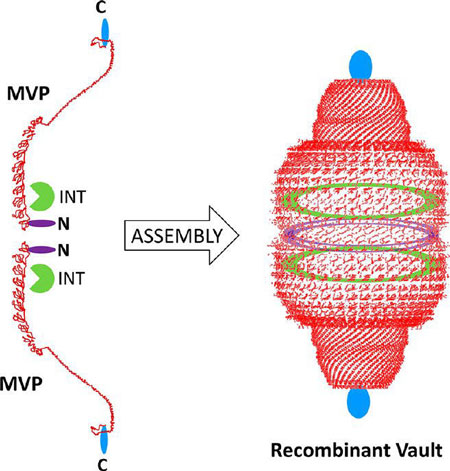| Posted: Aug 19, 2013 | |
Vault particles as a nanotechnology platform |
|
| (Nanowerk Spotlight) Vault particles are large, barrel-shaped nanoparticles found in the cytoplasm of all mammalian cells. All human cells so far analyzed have been shown to contain vaults with quantities varying from a few thousand per cell to in excess of 100 000 per cell. | |
| As naturally occurring nanoscale capsules, vaults may be useful to engineer as therapeutic delivery vehicles. The particles can be produced in large quantities and are assembled in situ from multiple copies of the single structural protein following expression. Using molecular engineering, recombinant vaults can be functionally modified and targeted, and their contents can be controlled by packaging. | |
| A review article in ACS Nano ("Development of the Vault Particle as a Platform Technology") by Leonard H. Rome and Valerie A. Kickhoefer from UCLA, takes a look at the development of engineered vaults as a platform for a wide variety of therapeutic applications and examines future directions for this unique nanoparticle system. | |
| Rome's lab website on UCLA has extensive information about vault nanoparticle research and the team have published numerous studies (see for instance "Nanoscale vaults encapsulate nanodisks for drug delivery" and "Natural protein vaults for nanotechnology cargo applications"). | |
| As researchers began to analyze vault expression in insect cells, they conceived the idea that these vault particles could also be engineered in the lab. They finally concluded that the entire vault structure could be formed by assembly of multiple copies of just one protein (named the major vault protein, or MVP) – a surprising finding. While earlier models predicted a structure that contained 96 MVP copies per vault, the currently predominant opinion seems to be that 78 copies is the right number. However, the possibility still remains that vaults may have a variable number of MVPs (78 (± n). | |
 |
|
| Schematic diagram of vault engineering. Two single MVP chains are illustrated on the left in red with the locations indicated where additional amino acids can be added at the N-terminus (purple) and C-terminus (blue). The INT peptide is illustrated in green aligned with its binding site on MVP. Assembly of the various MVP chains into a vault is illustrated on the right. The purple MVP N-terminal peptide extensions are located on the interior surface of the engineered vault particles at the waist (shown as two purple discs). The blue MVP C-terminal peptide extensions are located on the exterior surface of the particles at the end of the caps. When vaults are packaged with exogenous proteins fused to the INT domain, these proteins form two rings of density inside the particle (shown as two green discs). (Reprinted with permission from American Chemical Society) | |
| The biocompatibility of vaults and the ability to encapsulate and protect fluorescent materials inside provides a wide range of possibilities for vaults as inert markers for biological imaging. Moreover, understanding how to encapsulate macromolecules inside vaults and developing strategies to seal them is an important step toward the use of vault protein cages as vessels for drug delivery. | |
| There are several aspects that make vault particles useful as a therapeutic delivery system. 1) The particle has many of the properties thought to be advantageous for such a system. First, the particle's size (<100 nm) is small enough to prevent it from being trapped in the kidney and/or liver if administered intravenously. 2) The particle has a large interior space, large enough to encapsulate hundreds of proteins. 3) The protein shell of the vault offers some protection from external proteases. 4) Vaults appear to be biodegradable. Finally, vaults are nonimmunogenic. | |
| In their review, the authors write that, "since proteins packaged into vaults through domain binding interactions appear to be reversibly associated with the particles, vaults seem most appropriate for applications where the slow release of proteins or peptides is desired. One particularly promising use of vaults has been to deliver an immune activating peptide intratumorally for the purpose of initiating antitumor immune responses in lung cancer." | |
| Concluding their review, they point out that as a delivery system, the vault nanoparticle has incredible potential, yet only a few applications have thus far been investigated. In vitro applications, such as the use of vaults as delivery regents for biological materials, are likely to be the first commercial applications for the particle. | |
| "In light of the variety and ease of vault engineering that can be anticipated, it is tempting to speculate a number of futuristic applications for the particle ranging from intracellular biological sensors to flexible nanomachine component parts. These flights of imagination are possible because of the elegant structure of the vault and the myriad of possibilities for engineering the particle using standard molecular biology techniques." | |
 By
Michael
Berger
– Michael is author of three books by the Royal Society of Chemistry:
Nano-Society: Pushing the Boundaries of Technology,
Nanotechnology: The Future is Tiny, and
Nanoengineering: The Skills and Tools Making Technology Invisible
Copyright ©
Nanowerk LLC
By
Michael
Berger
– Michael is author of three books by the Royal Society of Chemistry:
Nano-Society: Pushing the Boundaries of Technology,
Nanotechnology: The Future is Tiny, and
Nanoengineering: The Skills and Tools Making Technology Invisible
Copyright ©
Nanowerk LLC
|
|
|
Become a Spotlight guest author! Join our large and growing group of guest contributors. Have you just published a scientific paper or have other exciting developments to share with the nanotechnology community? Here is how to publish on nanowerk.com. |
|
